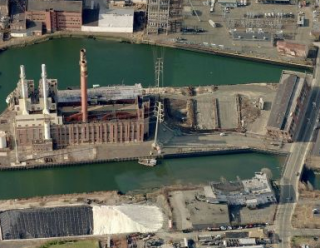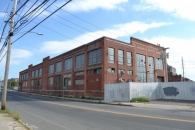Mill Record New Haven
RETURN TO ‘FIND MILLS’Disclaimer: Content for these properties was compiled in 2014-2017 from a variety of sources and is subject to change. Updates are occasionally made under Property Information, however the Connecticut Trust for Historic Preservation (dba Preservation Connecticut) makes no representation or warranty that the information is complete or up-to-date.
- Complex Name (Common)
- United Illuminating Co., English Station
- Complex Name (Historic)
-
- United Illuminating Co., English Station
- Address or Location
- 510 Grand Avenue, New Haven
- County
- New Haven
- Historic Designation
- Associated Mill Community
- n/a

- Historic Information
Companies Associated w/Complex
- United Illuminating Co., English Station ca. 1920-1992
Use (Historic)
- Other: Power generation
Largest Documented Workforce
Unknown.
Historic Narrative
The origins of the United Illuminating Company date to 1881 and the organization of the New Haven, Connecticut-based New Haven Electric Lighting Company. This fledgling utility struggled from the start, however, and was reorganized as the New Haven Electric Company in 1883. The latter firm began as many nascent electrical companies in the period did, namely by supplying annual contracts for individual lighting units. This model was soon replaced by system-based electrical service and the New Haven Electric Company expanded rapidly by marketing its services to businesses and institutions, among them being Yale College. The firm continually increased its capacity through the 1880s and 1890s, and by the late 1890s set its sights beyond the boundaries of New Haven. In 1899, James English, president of both the New Haven Electric Company and the Bridgeport, Connecticut-based Bridgeport Electric Light Company, moved to merge the two firms under his leadership as well as acquire a number of other electrical utilities in the vicinity of New Haven. The United Illuminating Company was incorporated for this purpose, with the acquired firms consisting of the Bridgeport Illuminating Company, the Stratford Gas and Electric Company, and the West Haven Power Company. The United Illuminating Company was led by English as president, with an assortment of officers from the other firms serving as management and a board of directors. It boasted $200,000 in initial capital. English’s move proved prudent almost immediately as the company posted profits of $36,515 on its first annual revenues of $428,539. By 1919, these numbers had grown to $140,000 and $3 million, respectively, with further increases to $541,000 and $8 million in 1930. The company continually expanded its customer base within the New Haven-Bridgeport metro market yet largely resisted large mergers of the likes that had initially created the business. The utility made significant improvements to its generation and distribution systems during this period, with substantial new powerplants erected in both New Haven and Bridgeport during the 1920s. These improvements included replacing one of its earliest generation stations on Grand Avenue in New Haven ca. 1920, building the notable Steel Point Power Station in Bridgeport in 1922, and then expanding the New Haven facilities on Grand Avenue through the construction of the massive English Station, this named after the company’s founder, at a cost of $3,250,000 in 1929. By 1930, increased capacity had driven the total number of the utility’s customers to over 116,000. The United Illuminating Company continued to expand during the 1940s and 1950s, largely as a result of the post-war American consumer boom. The utility made additional improvements to its New Haven and Bridgeport plants during the 1950s, however, during the 1960s the firm’s management became increasingly amicable towards cooperation with other utilities. In 1962, the company partnered with the Connecticut Yankee Atomic Power Company to build a nuclear power plant at Haddam Neck, Connecticut, and in 1971 joined the New England Power Pool, a sort of emergency-based generation and transmission cooperative. Further sourcing of power production included investment in a nuclear power plant in Seabrook, New Hampshire in the late 1970s, and in the Millstone nuclear power plant in Waterford, Connecticut, in the 1990s. This focus on nuclear energy, as well as increased investment in hydro power, allowed United Illuminating to make a shift away from its reliance on fossil fuels during the 1990s and a number of coal- and oil-fired powerplants were decommissioned, including the English Station, which was closed down in 1992. The United Illuminating Company remains a regionally-based utility and today serves roughly 325,000 customers in the New Haven-Bridgeport metropolitan area.
- Architectural Information
Number of Existing Buildings
Seven (7) primary blocks.
Dates of Construction
ca. 1920, 1927, ca. 1955.
Architect
n/a
Builder
n/a
Building Type
Architectural Description
The former United Illuminating Company’s English Station generation plant is comprised of roughly seven primary adjoining and freestanding blocks located on the south side of Grand Avenue, and comprising the entire portion of the small island (known as ‘English Island’) located in the middle of the Mill River south of Grand Avenue. The oldest building associated with the property is located immediately south of Grand Avenue and is a two-story, 278’ x 80’ red brick block erected ca. 1920. This building replaced an earlier generation plant built on the site during the 1890s and originally had a second block of equal size adjoining its south elevation (this demolished during the 1940s). The surviving portion of the ca. 1920 plant served as a generator house and has a concrete foundation and watertable, red brick walls, large rectangular window openings with concrete sills and spandrel panels, multi-pane metal sash with pivot-style openings, a corbelled brick cornice, concrete coping, and a flat roof with a single clerestory monitor. Two blind bays on the façade (north elevation) rise to raised parapets with brick corbelling and concrete coping. The bays appear to retain the remnants of dozens of conduits on the second story where electrical wires may have formerly exited the building. Once decommissioned during the 1940s, the structure served as storage for the larger ‘English Station’ roughly 500’ to the south. The earliest portion of the English Station was erected by the United Illuminating Company between 1927 and 1929. The plant originally measured roughly 184’ x 300’, yet was enlarged to approximately 184’ x 440’ ca. 1955. The original blocks are of brick pier construction and bear blended influences of the Collegiate Gothic and Art Deco styles in their towering crenellated walls, large round- and pointed-arched door and window openings, and geometric wall detailing. The original building consists of three primary red brick blocks, a six-story boiler room, a five-story turbine room, and a four-story office wing. Several three-story accessory ells adjoin the west elevation of the original facility. The façade (north elevation) of the boiler room bears a massive, four-story reinforced concrete pavilion with multi-story recessed door and window openings. This is embossed with a variety of decorative elements and rises to a two-story red brick tower with round-arched windows and a crenellated parapet. The parapet is similar to those found throughout the remainder of the plant, however, other sections of the building bear additional detailing such as cast stone quoins, cornices, frieze panels, and coping, and various arrangements of diamond-shaped tile plaques. The windows throughout the original facility are largely placed in full-height bays, some interrupted by cast stone spandrels and others unbroken the full height of the respective block. The fenestration is multi-pane metal sash with pivot-style openings. A pair of roughly sixteen-story-tall cylindrical red brick chimneys rise from the boiler house and are decorated with black and buff brick striping near their tops. Enlargement of the English Station consisted of expanding both the boiler house and turbine room. The details of the addition to the turbine room largely mimic the original construction, however, the new boiler house is of steel-frame construction with a mix of corrugated metal siding and red brick veneer. The addition is of Modern styling and towers some ten stories tall overall. The south elevation and the portion of the building that rises above the original plant has wide ribbon widows with multi-pane metal sash, these wrapping around the corners of the building on its eighth story. Two cylindrical metal chimney rise from the east side of the block to a height even with the original smokestacks.
Exterior Material(s)
Structural System(s)
Roof Form
Roof Material
Power Source
Condition
Fair, Deteriorated
Condition Notes
The complex is in fair to deteriorated condition. Many of the exterior walls are in need of repairs and a number of the original windows throughout the complex have been infilled or are damaged.
- Property Information
-
Specific Location
One legal parcel (510 Grand Avenue) totaling 5.32 acres located on the south side of Grand Avenue, and comprising all of the portion of the small island (known as ‘English Island’) located in the middle of the Mill River south of Grand Avenue.
Adjacent To
Exterior Visible from Public Road?
Yes
Parcel ID / Assessor Record Link
- 197/0442/00100. / Link →
Acreage
5.32
Use (Present)
- Abandoned
- Other: Demolition of the northern brick building on Grand Avenue planned by UI as of 10/2018. Remediation began in 2017 and planned for completion end 2019, but as of 2025 UI/Avangrid have not fulfilled remediation under EDDP consent order. 7/2025 NH mayor Elicker proposed purchase by the city for a waterfront park, once UI/Avangrid have completed remediation.
- Sources
-
Form Completed By
Lucas A. Karmazinas
Date
10/08/2015
Bibliography
- List of Connecticut Manufacturers, 1922, 1924, 1930, 1932.
- Directory of Connecticut State Manufacturers, 1936, 1939.
- Industrial Directory of Connecticut, 1947.
- Register of War Production Facilities in Connecticut, 1951.
- Map of New Haven County; Clark, Richard, 1859.
- Atlas of New Haven County, Beers, Ellis & Soule, 1868.
- Aerial Survey of Connecticut, 1934, 1965.
- Sanborn Map Company, 1901, 1911, 1923, 1950.
- New Haven City Directory; Various editions.
- History of the City of New Haven to the Present Time, 1887.
- A Modern History of New Haven and Eastern New Haven County, 1920.
- UI: History of an Electric Company; Fassett, John D., 1991.
- Hartford Courant, 1899, 1927, 1932, 1988.
- Representative View(s)Click on image to view full file







